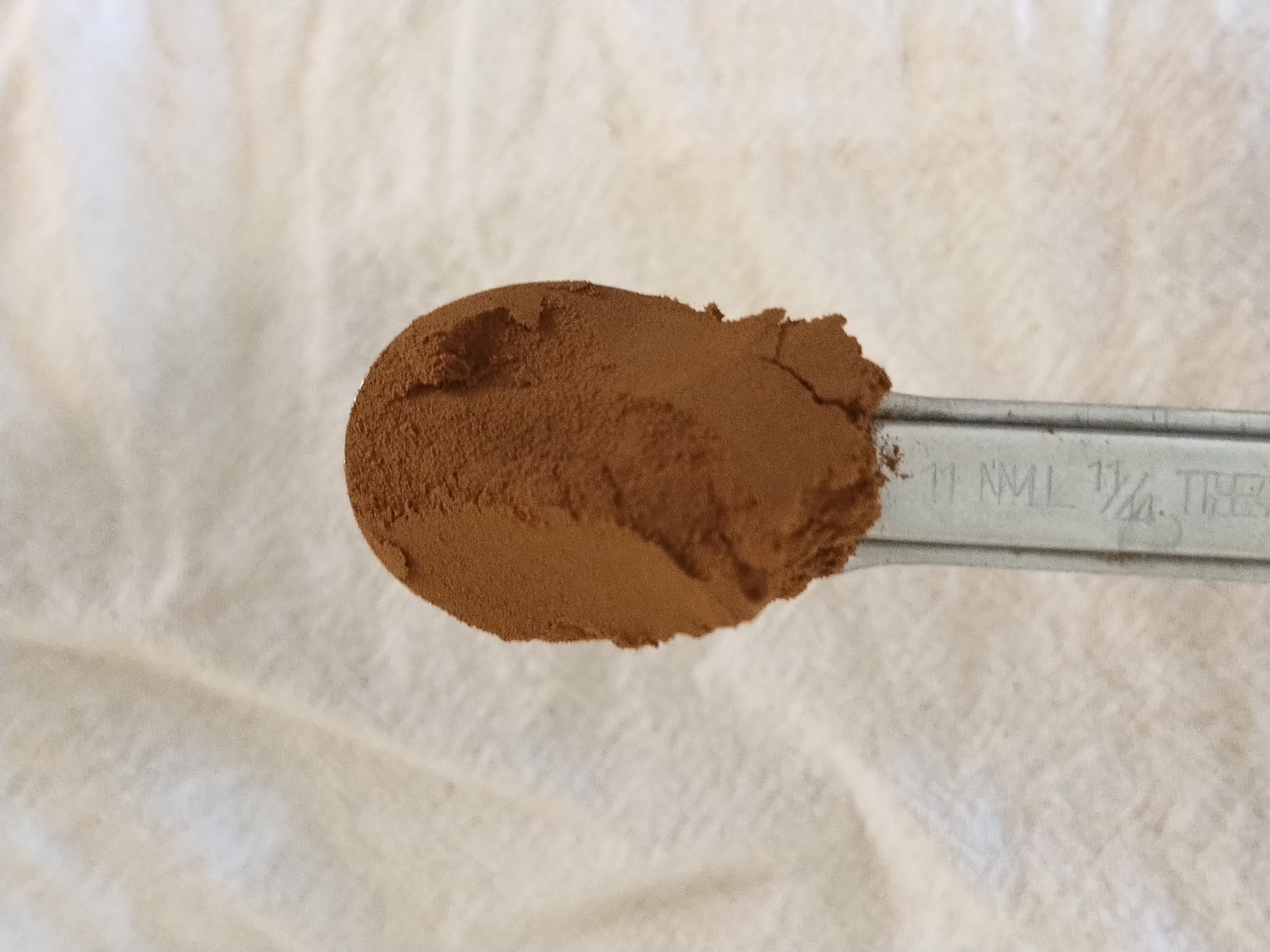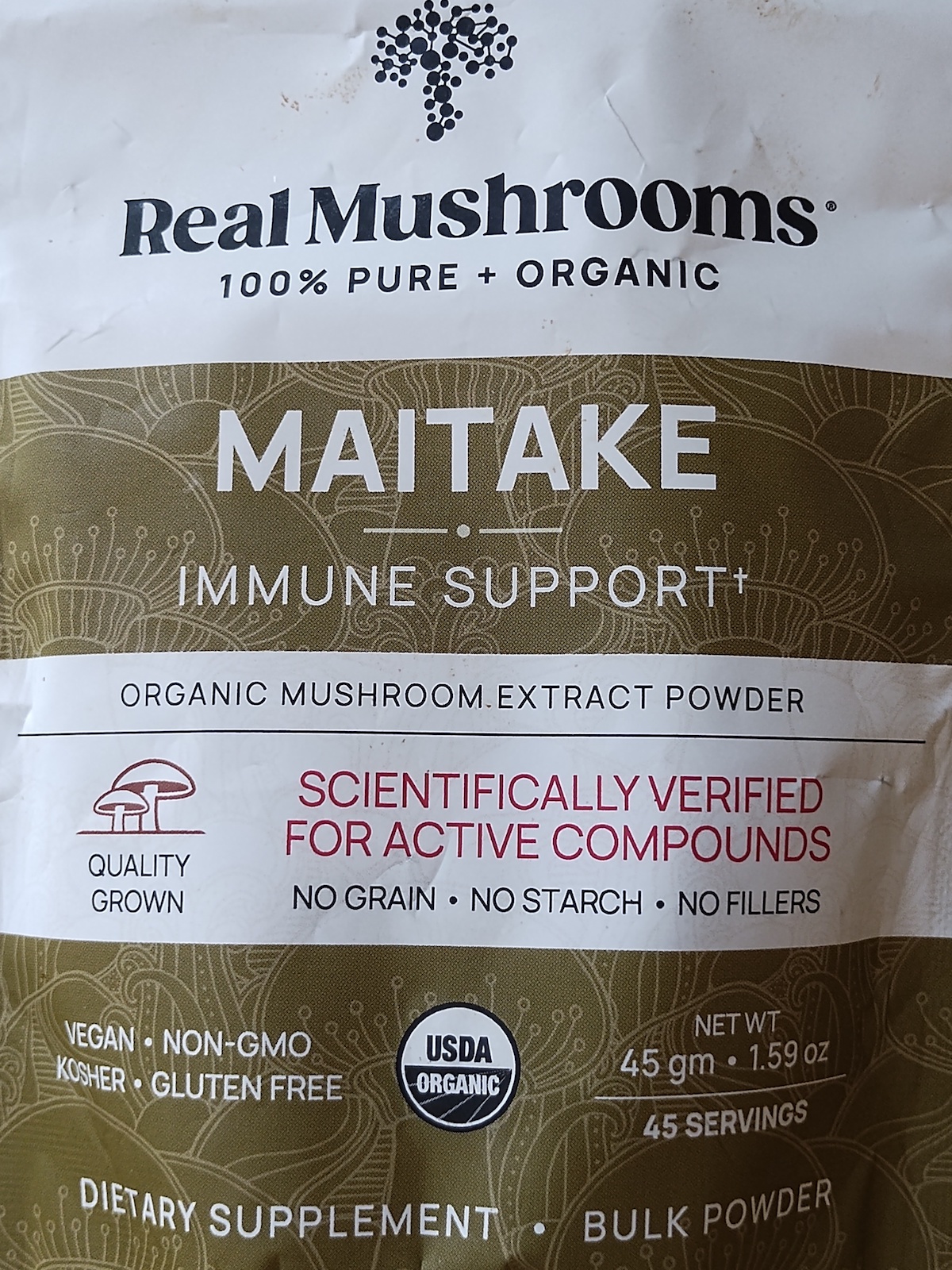Maitake Mushroom: Whole-Food Copper Source Including Synergistic Copper-Binding-Peptide
by Jon Sasmor RCPC (Mineral Guide, MinBalance LLC)
Updated
January 8, 2025
Contents
- Copper Content of Maitake
- Maitake Mushroom Fruiting Body Contains a Synergistic Copper-Binding-Peptide!
- Horizons for Future Research About Copper in Maitake
- How About White Button Mushrooms as a Copper Source?
- Extraction Increases Nutrient Bioavailability
- Who Might Improve Copper Status with Maitake Mushrooms?
- References
 Maitake extract powder on spoon.
Maitake extract powder on spoon.
Copper Content of Maitake
Dr. Rob Silver, DVM, MS, of Real Mushrooms, recently mentioned that among the Real Mushrooms products, the highest content of copper occurred in maitake mushroom at 21.7 mcg/g dry weight in one batch that was tested. (R. Silver, personal communication, 2024, June 25).
Accordingly, a label serving (1 gram) of Real Mushrooms organic maitake extract, which is either 2 capsules or 1/2 tsp powder, would contain 21.7 mcg = 0.0217 mg of copper.
(The same Nammex-supplied organic maitake fruiting body extract seems to be sold internationally as MyPure Maitake by Pure Essence. Similarly, 2 capsules of MyPure Maitake would contain 21.7 mcg = 0.0217 mg of copper.)
The tested batch's copper content matches well with the 8 samples from varying parts of the United States included in the USDA's 2021 testing of maitake: average copper content was 26.1 mcg/g dry weight. [calculated as (0.272mg copper / 100g wet weight) * (1000 mcg/mg) * (100g wet weight / (100g - 90.4g) dry weight]. (USDA, 2021a.)
The overall copper amount in maitake might seem relatively small. But, due to the nutrient synergists in foods like mushrooms, sometimes small mineral amounts from food-based sources such as mushrooms can be more effective than isolated larger amounts.
Nature seems to package nutrients together with synergists that make the food-based nutrient microdoses more powerful than their numerical amounts suggest. The nutrient synergism helps the food grow while it's alive, and then helps whoever eats the food.
Because of the synergists, those tens of micrograms can matter much more, when they come from food, especially when a specific mushroom or herb concentrates a certain mineral over others.
Maitake Mushroom Fruiting Body Contains a Synergistic Copper-Binding-Peptide!
Research from the lab of Dr. Yoshinori Itokawa isolated a copper-binding-peptide in maitake (Grifola frondosa) mushroom fruiting bodies. The researchers selected maitake because it contained the highest amount of copper compared with other Japanese mushrooms such as oyster (Pleurotus ostreatus) and shiitake (Lentinus edodes) mushrooms. (Shimaoka et al., 1993.)
The peptide from maitake fruiting body binds copper in a 1:1 molar ratio and seems to make copper more soluble. (Shimaoka et al., 1993.)
The same lab then tested the effect of this peptide in rats. The maitake copper-binding-peptide enhanced copper absorption, as shown by increased copper concentration in portal vein blood. Also, compared with rats given copper alone, those given the maitake copper-binding-peptide in addition to copper had double the content of copper in their livers. (Shimaoka et al., 1994.)
Thus, it seems that the copper-binding-peptide naturally present in maitake fruiting body enhances in rats both copper absorption and copper delivery to the liver. (Shimaoka et al., 1994.)
Horizons for Future Research About Copper in Maitake
- Does the same enhancement of copper absorption and copper delivery to liver occur in humans who eat maitake fruiting body?
- How much does copper uptake and delivery improve from the amounts of maitake eaten fresh or as whole-food supplements?
- How much benefit might we see on copper-related laboratory markers?
- How much maitake fruiting body should we eat to enhance copper status and improve ceruloplasmin function?
- Might the tens of micrograms of copper present in a serving of maitake be much more valuable than their numbers seem, because of the effects of maitake's synergistic copper-binding-peptide?
To my knowledge, studies about these exciting questions remain to be done. Maitake has been eaten traditionally for ages, and is among the most popular mushrooms in Japan. So maitake is a safe and nutritious part of an ancestral diet, even without knowing exactly how much maitake benefits the copper status of those who need more copper.
And, maitake has many more health benefits — see the maitake review article on Real Mushrooms' website for details (Real Mushrooms, 2024).
Extraction Increases Nutrient Bioavailability
The hot water extraction process of making a dried mushroom supplement breaks open the chitinous cell walls and makes nutrients more bioavailable. Traditional methods of cooking mushrooms in teas or decoctions accomplish the same benefit — extracting nutrients. (Chilton, 2024.)
Therefore, the copper and copper-binding-peptide in maitake mushroom extract may be more bioavailable than in fresh maitake mushrooms. This increased bioavailability makes the capsule and powder forms a convenient and appealing modern option to enjoy the benefits of maitake, especially for those who don't have easy access to fresh maitake.
Who Might Improve Copper Status with Maitake Mushrooms?
Maitake is an exciting traditional food that provides copper and at least one natural copper synergist. Maitake also may contain additional unknown natural copper synergists, due to Nature's propensity for synergisms in natural foods. Copper and copper synergists are but one reason for the benefits of traditional consumption of maitake mushroom.
Consider organic maitake mushroom fruiting body as a copper source:
- if you prefer a whole-food source of copper,
- if you have sensitive reactions to copper supplements and would like to try starting with a microdose,
- if you are taking a copper supplement and would like to add the natural copper synergists in maitake to make your copper supplement more potent and effective,
- if you have supplemented with copper for a period of time and have replenished your body copper, and now are looking for a gentle lower-dose copper option for maintenance, or,
- as a delicious nutritious traditional source of copper and copper synergists and many other nutrients, as part of an organic ancestral whole-foods diet.
References
- Chilton, S. (2024, June 17). The art of mushroom extraction: Methods for maximum extract potency. Real Mushrooms. https://www.realmushrooms.com/mushroom-extraction/
- Real Mushrooms. (2024, June 11). Maitake mushroom: Profiling the health benefits of "hen of the woods". https://www.realmushrooms.com/maitake-mushroom-health-benefits/
- Shimaoka, I., Ishiyama, S., Nishino, K., & Itokawa, Y. (1994). Effects of a copper-binding peptide from the mushroom Grifola frondosa on intestinal copper absorption. Nutrition Research, 14(9), 1331-1337. https://doi.org/10.1016/S0271-5317(05)80293-3
- Shimaoka, I., Kodama, J., Nishino, K., & Itokawa, Y. (1993). Purification of a copper binding peptide from the mushroom Grifola frondosa and its effect on copper absorption. The Journal of Nutritional Biochemistry, 4(1), 33-38. https://doi.org/10.1016/0955-2863(93)90017-Q
- U.S. Dep't of Agriculture (2021a, October 28). Foundation data: Mushroom, maitake. FoodData Central. https://fdc.nal.usda.gov/fdc-app.html#/food-details/2003602/nutrients
- U.S. Dep't of Agriculture (2021b, October 28). Foundation data: Mushroom, white button. FoodData Central. https://fdc.nal.usda.gov/fdc-app.html#/food-details/1999629/nutrients
